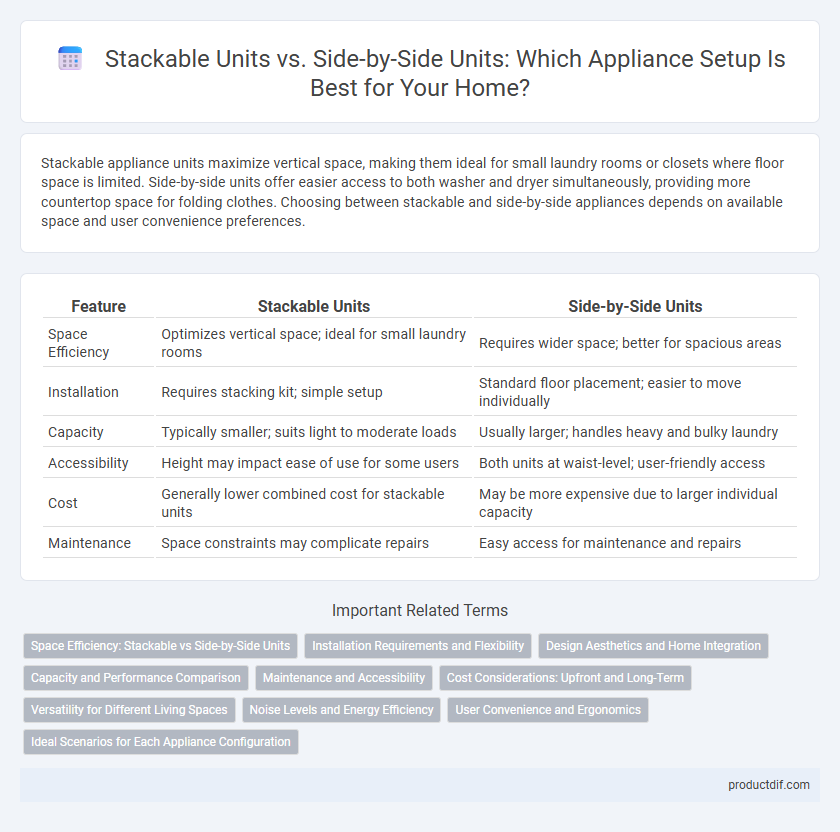Stackable appliance units maximize vertical space, making them ideal for small laundry rooms or closets where floor space is limited. Side-by-side units offer easier access to both washer and dryer simultaneously, providing more countertop space for folding clothes. Choosing between stackable and side-by-side appliances depends on available space and user convenience preferences.
Table of Comparison
| Feature | Stackable Units | Side-by-Side Units |
|---|---|---|
| Space Efficiency | Optimizes vertical space; ideal for small laundry rooms | Requires wider space; better for spacious areas |
| Installation | Requires stacking kit; simple setup | Standard floor placement; easier to move individually |
| Capacity | Typically smaller; suits light to moderate loads | Usually larger; handles heavy and bulky laundry |
| Accessibility | Height may impact ease of use for some users | Both units at waist-level; user-friendly access |
| Cost | Generally lower combined cost for stackable units | May be more expensive due to larger individual capacity |
| Maintenance | Space constraints may complicate repairs | Easy access for maintenance and repairs |
Space Efficiency: Stackable vs Side-by-Side Units
Stackable units maximize vertical space, making them ideal for small laundry rooms or tight closets where floor space is limited. Side-by-side units require more horizontal space but allow for a wider surface area on top, which can be used for folding or storage. Choosing stackable appliances enhances space efficiency by utilizing unused height, while side-by-side units provide accessibility and convenience without compromising storage options.
Installation Requirements and Flexibility
Stackable units require less floor space, making them ideal for small laundry areas, but they often need reinforced wall support and specific electrical hookups for safe installation. Side-by-side units allow for more flexibility in placement since they only require standard connections and ample floor space without additional structural modifications. Both options demand careful consideration of venting, water supply, and drainage requirements to ensure optimal performance and safety.
Design Aesthetics and Home Integration
Stackable units offer a compact design ideal for maximizing vertical space, making them perfect for small or narrow laundry areas while maintaining a sleek, modern look. Side-by-side units provide a symmetrical appearance and easy access to both washer and dryer simultaneously, often blending seamlessly with cabinetry or built-in shelving for a cohesive home integration. Both options enhance home aesthetics but cater to different spatial and stylistic preferences, with stackable units emphasizing space efficiency and side-by-side units highlighting accessibility and balanced design.
Capacity and Performance Comparison
Stackable units maximize vertical space, offering compact capacity ideal for small laundry areas, while side-by-side units provide larger overall capacity suitable for handling bigger loads efficiently. Performance in stackable models often includes shorter cycle times and energy-efficient features tailored for tight spaces. Side-by-side units typically deliver higher washing and drying power with advanced settings, ensuring superior performance for heavy-duty laundry needs.
Maintenance and Accessibility
Stackable units offer compact design that simplifies maintenance by allowing easy access to individual appliances without moving heavy components. Side-by-side units provide greater accessibility for repairs due to their separate compartments, making it easier to isolate and service specific parts. Both configurations require regular cleaning and inspection, but stackable units may demand more effort to reach back components compared to side-by-side arrangements.
Cost Considerations: Upfront and Long-Term
Stackable units generally have a lower upfront cost compared to side-by-side units, making them an affordable option for smaller spaces and budgets. Long-term energy consumption is typically lower in stackable units due to their compact design and efficient performance. Side-by-side units may incur higher upfront investment but offer greater capacity and convenience, potentially reducing replacement costs over time.
Versatility for Different Living Spaces
Stackable units maximize vertical space, making them ideal for compact apartments or homes with limited floor area, while side-by-side units offer larger capacity and easier access to both washer and dryer simultaneously, suited for spacious laundry rooms. Stackable designs enhance versatility by fitting into closets or narrow spaces, whereas side-by-side configurations provide more countertop or storage options above the appliances. Choosing between stackable and side-by-side units depends on balancing space constraints with laundry needs and workflow preferences.
Noise Levels and Energy Efficiency
Stackable units typically produce less noise due to their compact design and insulated components, making them suitable for smaller spaces where quiet operation is essential. Side-by-side units offer better airflow and cooling efficiency, often resulting in lower energy consumption despite their larger size. Energy Star ratings for both types indicate that stackable units may use less energy overall, but side-by-side models excel in maintaining consistent temperatures, which can reduce power usage over time.
User Convenience and Ergonomics
Stackable units maximize vertical space, making them ideal for small laundry rooms while offering easier access when positioned at eye level, reducing the need to bend or stretch. Side-by-side units provide wider countertops for folding and sorting clothes, enhancing workflow efficiency but often require more floor space. Ergonomically, stackable units support better posture during loading and unloading, whereas side-by-side models allow simultaneous use of washer and dryer without shifting positions.
Ideal Scenarios for Each Appliance Configuration
Stackable units are ideal for small spaces like apartments or laundry closets where vertical space maximization is crucial, offering efficient use of limited square footage. Side-by-side units are better suited for larger laundry rooms, providing expansive countertop space between appliances and easier access for folding and sorting clothes. Both options cater to specific needs based on room size and workflow preferences, optimizing convenience and space utilization.
Stackable units vs Side-by-side units Infographic

 productdif.com
productdif.com